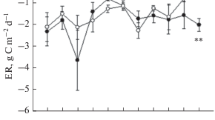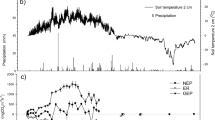Summary
Whole ecosystem CO2 flux under ambient (340 μl/l) and elevated (680 μl/l) CO2 was measured in situ in Eriophorum tussock tundra on the North Slope of Alaska. Elevated CO2 resulted in greater carbon acquisition than control treatments and there was a net loss of CO2 under ambient conditions at this upland tundra site. These measurements indicate a current loss of carbon from upland tundra, possibly the result of recent climatic changes. Elevated CO2 for the duration of one growing season appeared to delay the onset of dormancy and resulted in approximately 10 additional days of positive ecosystem flux. Homeostatic adjustment of ecosystem CO2 flux (sum of species' response) was apparent by the third week of exposure to elevated CO2. Ecosystem dark respiration rates were not significantly higher at elevated CO2 levels. Rapid homeostatic adjustment to elevated CO2 may limit carbon uptake in upland tundra. Abiotic factors were evaluated as predictors of ecosystem CO2 flux. For chambers exposed to ambient and elevated CO2 levels for the duration of the growing season, seasonality (Julian day) was the best predictor of ecosystem CO2 flux at both ambient and elevated CO2 levels. Light (PAR), soil temperature, and air temperature were also predictive of seasonal ecosystem flux, but only at elevated CO2 levels. At any combination of physical conditions, flux of the elevated CO2 treatment was greater than that at ambient. In short-term manipulations of CO2, tundra exposed to elevated CO2 had threefold greater carbon gain, and had one half the ecosystem level, light compensation point when compared to ambient CO2 treatments. Elevated CO2-acclimated tundra had twofold greater carbon gain compared to ambient treatments, but there was no difference in ecosystem level, light compensation point between elevated and ambient CO2 treatments. The predicted future increases in cloudiness could substantially decrease the effect of elevated atmospheric CO2 on net ecosystem carbon budget. These analyses suggest little if any long-term stimulation of ecosystem carbon acquisition by increases in atmospheric CO2.
Similar content being viewed by others
References
Bazzaz FA, Garbutt K, Williams WE (1985) Effect of increased atmospheric CO2 concentration on plant communities. In: Strain BR, Cure JD (eds) Direct effects of increasing carbon dioxide on vegetation. (DOE/ER-028), pp 155–170. US Department of Energy, Carbon Dioxide Research Division, Washington, D.C.
Billings WD (1987) Carbon balance of Alaskan tundra and taiga ecosystems: past, present and future. Q Sci Rev 6:165–177
Billings WD, Luken JO, Mortensen DA, Peterson KM (1982) Arctic tundra: A source or sink for atmospheric carbon dioxide in a changing environment? Oecologia 53:7–11
Billings WD, Luken JO, Mortensen DA, Peterson KM (1983) Increasing atmospheric carbon dioxide: possible effects on arctic tundra. Oecologia 58:286–289
Billings WD, Peterson KM, Luken JO, Mortensen DA (1984) Interaction of increasing atmospheric carbon dioxide and soil nitrogen on the carbon balance of tundra microcosms. Oecologia 65:26–29
Chapin FS III, Shaver GR, Kedrowski RA (1986) Environmental controls over carbon, nitrogen and phosphorus fractions in Eriophorum vaginatum in Alaskan tussock tundra. J Ecol 74:167–195
Coyne PI, Kelley JJ (1978) Meteorological assessment of CO2 exchange over an Alaskan arctic tundra. In: Tieszen LL (ed) Vegetation and Production Ecology of an Alaskan Arctic Tundra, Ecol Stud, Vol. 19, pp 299–319. Springer, Berlin Heidelberg New York
Flanagan PW, Bunnell FL (1980) 9. Microflora Activities and Decomposition. In: Brown J, Miller PC, Tieszen LL, Bunnell FL (eds) An Arctic Ecosystem: The Coastal Tundra at Barrow, Alaska. US/IBP Synthesis Series, Vol. 12, pp 291–334. Dowden, Hutchinson, and Ross, Inc., Stroudsberg, PA
Idso SB, Kimball BA, Anderson MG, Mauney JR (1982) Effects of atmospheric CO2 enrichment on plant growth: the interactive role of air temperature. Agri Eco Environm 20:1–10
Johnson DA, Tieszen LL (1976) Aboveground biomass allocation, leaf growth, and photosynthesis patterns in tundra plant forms in arctic Alaska. Oecologia 24:159–173
Keeling CD (1983) The global carbon cycle: what we know and what we could know from atmospheric, biospheric and oceanic observations. In: Proceedings of the CO2 Research Conference: CO2, Science, and Consensus (CONF-820970). US Department of Energy, Carbon Dioxide Research Division, Washington, D.C.
Kimball BA (1986) CO2 stimulation of growth and yield under environmental constraints. In: Enoch HZ, Kimball BA (eds). Carbon Dioxide Enrichment of Greenhouse Crops, Vol II. pp 53–67. Physiology, Yield, and Economics. CRC Press, Boca Raton, Florida
Kimball BA, Mauney JR, Radin JW, Nakayama FS, Idso SB, Hendrix DL, Akey DH, Allen SG, Anderson MG, Hartung W (1986) Response of vegetation to CO2: effects of increasing atmospheric CO2 on growth, water relations, and physiology of plants grown under optimal and limiting levels of water and nitrogen. Progress Report, Vol. 39, p 125. US Department of Energy, Carbon Dioxide Research Division, Washington, D.C.
Lemon ER (ed) (1983) CO2 and Plants: The Response of Plants to Rising Levels of Atmospheric Carbon Dioxide, p 208. Westview Press, Boulder, Colorado
Manabe S, Stouffer RJ (1979) A CO2 climate sensitivity study with a mathematical model of the global climate. Nature 282:491–493
Manabe S, Wetherald RT (1975) The effects of doubling the CO2 concentration on the climate of a general circulation model. J Atmos Sci 32:3–15
Miller PC (ed) (1981) Carbon balance in northern ecosystems and the potential effect of CO2-induced climate change. (CONF-8003118), p 109. US Department of Energy, Carbon Dioxide Research Division, Washington, D.C.
Miller PC, Kendall R, Oechel WC (1983) Simulating carbon accumulation in northern ecosystems. Simulation 40:119–131
Mooney HA, Billings WD (1961) Comparative physiological ecology of arctic and alpine populations of Oxyria digyna. Ecol Monogr 31:1–229
Oberbauer SF, Oechel WC (1989) Maximum CO2-assimilation rates of vascular plants on an Alaskan arctic tundra slope. Hol Ecol 12:312–316
Oberbauer SF, Sionit N, Hastings SJ, Oechel WC (1986a) Effects of CO2 enrichment and nutrition on growth, photosynthesis, and nutrient concentration of Alaskan tundra plant species. Can J Bot 64:2993–2998
Oberbauer SF, Oechel WC, Riechers GH (1986b) Soil respiration of Alaskan tundra at elevated atmospheric CO2 concentrations. Plant Soil 46:145–148
Oechel WC (1976) Seasonal patterns of temperature response of CO2 flux and acclimation in arctic mosses growing in situ. Photosynthetica 10:447–45
Oechel WC, Strain BR (1985) Native species responses to increased CO2 concentration. In: Strain BR, Cure JD (eds) Direct Effects of Increasing CO2 on Vegetation. (DOE/ER-028), pp 117–154. US Department of Energy, Carbon Dioxide Research Division, Washington, D.C.
Schell D (1988) Peat carbon in arctic Alaska: accumulating or ablating? Eos 69(44):1127
Seidel S, Keyes D (1983) Can we delay a greenhouse warming? The effectiveness and feasibility of options to slow a build-up of CO2 in the atmosphere. Strategic Studies Staff, Office of Policy Studies, US EPA, Washington, D.C.
Shaver GR, Cutler JC (1979) The vertical distribution of live vascular phytomass in cotton grass tussock tundra. Arc Alp Res 11:335–342
Sionit N, Mortensen DA, Strain BR, Hellmers H (1981) Growth response of wheat to CO2 on ichment and different levels of mineral nutrition. Agri J 73:1023–1026
Sionit N, Strain BR, Hellmers H (1982) Effects of different concentrations of atmospheric CO2 on growth and yield components of wheat. J Agri Sci 79:335–339
Tieszen LL, Miller PC, Oechel WC (1980) 4. Photosynthesis. In: Brown JH, Miller PC, Tieszen LL, Bunnell FL (eds) An Arctic Ecosystem: The Coastal Tundra At Barrow, Alaska. US/IBP Synthesis Series 12, pp 102–139. Dowden, Hutchinson and Ross, Inc., Stroudsberg, Pennsylvania.
Tissue DT, Oechel WC (1987) Response of Eriophorum vaginatum to elevated CO2 and temperature in the Alaskan arctic tundra. Ecology 68:401–411
TrabalkaJR (ed) (1985) Atmospheric CO2 and the Global Carbon Cycle. State of the Art Report (DOE/ER-0239) US Department of Energy, Office of Energy Research, Carbon Dioxide Research Division, Washington, D.C. p 315
Van Cleve K, Barney R, Schlentner RE (1981) Evidence of temperature control of production and nutrient cycling in two interior Alaska black spruce ecosystems. Can J For Res 11:258–273
Van Cleve K, Oliver LK, Schlentner R, Viereck LA, Dyrness CT (1983) Productivity and nutrient cycling in taiga forest ecosystems. Can J For Res 13:747–766
Wang WC, Wuebbles DJ, Washington WM (1985) 6. Potential climatic effects of perturbations other than CO2. In: MacCracken MC, Luther FM (eds) Projecting the Climatic Effects of Increasing CO2. (DOE/ER-0237), Office of Energy Research, Carbon Dioxide Research Division, Washington, D.C. pp 191–236
Wein RW, Bliss LC (1974) Primary production in arctic cotton-grass tussock tundra communities. Arc Alp Res 6:251–274
Author information
Authors and Affiliations
Rights and permissions
About this article
Cite this article
Grulke, N.E., Riechers, G.H., Oechel, W.C. et al. Carbon balance in tussock tundra under ambient and elevated atmospheric CO2 . Oecologia 83, 485–494 (1990). https://doi.org/10.1007/BF00317199
Received:
Accepted:
Issue Date:
DOI: https://doi.org/10.1007/BF00317199




